Personal Accomplishments
- CI/CD:
- Set up the Github repo to track dash cam side code
- Dash Cam Bringup:
- Integrated HTTP GET code to end to end script and got cache working to reduce the number of requests
- Integrated Andy’s UPS auto shutdown code to end to end script
- Integrated Sparkfun GPS-RTK module via USB serial to acquire GPS coordinates in the end to end script
- I2C connection was unsuccessful due to address conflict with the UPS module
- UART connection was unsuccessful for unknown reasons
- Added logging to end to end script, with auto ALPR on when power on and board shutdown when unplugging the cable
- Improved end to end script to only run OCR on horizontal detection boxes with >0.5 confidence and only send GET requests when recognized plate length is between 2 and 8 to reduce the number of requests
- Assisting Blues engineer to debug the GET json error
- Dash Cam Testing:
- Set up the dash cam to be installable on a car with a phone holder
- Worked with Christine and Andy to road test the dash cam in real world setting and validated ALPR and GET request capabilities
Progress
My progress is on schedule.
Schedule
- Central server integration and testing
- Opt-in switch module bringup and testing
- End-to-end pipeline debugging



